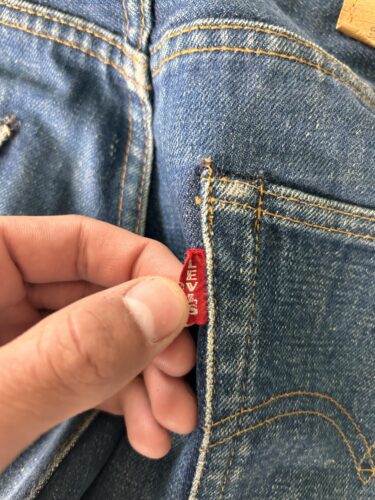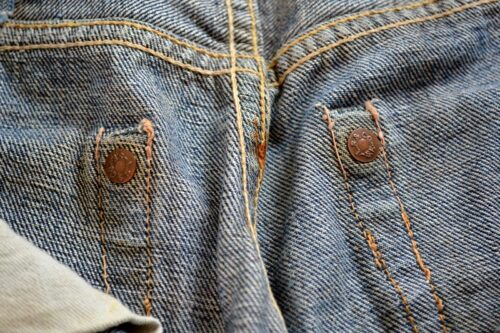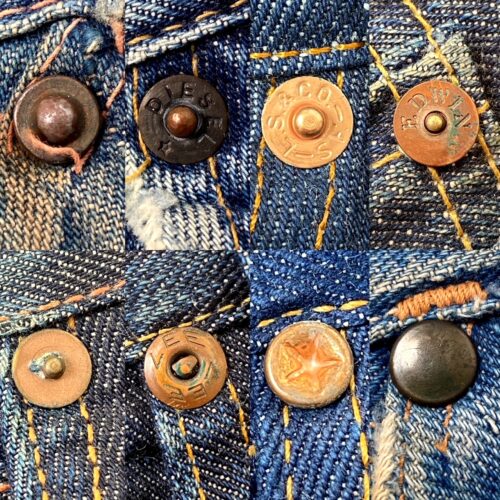The Big E Mystery: Vintage Levi’s Return to Lamy’s
Every now and then, something walks (or in this case, gets donated) through our doors that makes us stop mid–Old Fashioned sip and say, “Well, would you look at that.”
Recently, Cody, one of our team members, showed up with something pretty special — a donation from his grandmother, Betty Bowman. If that name rings a bell, it should. Betty was a seamstress here at Lamy’s back in the day and a star on our women’s softball team. Among her keepsakes? A pair of vintage Levi’s that made our history-loving hearts skip a stitch.
These jeans weren’t just old. They were pre-1966 old. And if you’re wondering how we figured that out, buckle up — this is where our denim detective work kicks in.

Clue #1: The Big “E”
See that little red tab on the back pocket? That’s not just decoration — it’s a timestamp. From the 1930s through 1971, Levi’s used a capital “E” on that red tab. After that, they switched to lowercase. So if your tab shouts LEVI’S instead of whispering Levi’s, congratulations — you’ve got a “Big E,” and you’re looking at denim that predates the disco era.
Ours? Big. Bold. E. ✔️
Clue #2: Rivets, Bar Tacks, and Cowboy Complaints
Back in the late 1800s, Jacob Davis and Levi Strauss started using rivets on jeans to keep the seams from giving out — especially at stress points like the pockets. Smart move, right? Except the cowboys wearing them started complaining that the exposed rivets were scratching their saddles (and, apparently, their wives’ furniture). You can assume this wasn’t a favored feature.

In 1937, Levi’s fixed the issue by moving the rivets to the inside of the pocket. Problem solved… sort of.
Those hidden rivets still had a habit of rubbing through the denim over time. So, in 1966, they ditched the rivets altogether and replaced them with something called a bar tack — basically heavy-duty stitching that does the same job without the metal.
Our pair? Sewn and riveted on the hip pockets — no bar tacks in sight. Translation: definitely pre-1966.
Clue #3: Button Backs Don’t Lie
Flip over the buttons on vintage Levi’s and you’ll usually find a little stamped number — a code that told you which factory they were born in. Ours are too worn to read (because, let’s be honest, they’ve lived a life), but if you know your Lamy’s history, you know our Sedalia plant was Factory No. 5.
So when you’re sipping a cocktail at No. 5 Bistro & Bar, that name isn’t random — it’s a nod to where jeans like these were once made. Could this very pair have rolled off the line here? We’ll never know for sure. But it’s a pretty sweet thought.

Why It Matters (And Why We’re Obsessed)
These jeans aren’t just fabric. They’re a piece of denim history — a tangible reminder of the era when this building hummed with sewing machines and stories. They’ve seen decades of dirt, labor, laughter, and likely a few questionable dance moves.
And now? They’ve come full circle, finding their way back to the place that might have made them, hanging proudly in our shadowbox at Lamy’s.
Come See the Big E for Yourself
Next time you’re at No. 5 for brunch or flipping through vinyl at Josey, stop and take a look at our newest little piece of history — the Big E Levi’s that may have come off the assembly line right here in Sedalia.
They’re a reminder that while we’ve swapped sewing machines for candle pouring, cocktails, and records, the story stitched into these walls is still very much alive. Come see us. History Loves Company.

